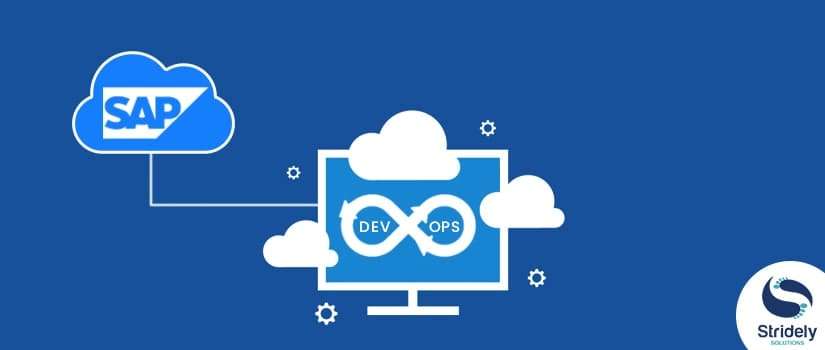SAP cloud is one of the trending platforms aiming to automate the digital workforce. With respect to DevOps, the implementation could either be a combined approach or one that allows SAP integration with DevOps on a standalone environment. Disregarding whichever is the case, it becomes imperative for the leaders and the tech enthusiasts to keep track of the various elements in the adoption of the SAP cloud portal for DevOps.
Going by its definition, DevOps are itself the amalgamation of development and the operational team so as to turn the entire process of developing more robust and result-driven. The same is more about a contingent approach entailing an efficient and agile methodology for both the phase of software development.
Needless to state that, incorporating a DevOps team not only enhances the workflow but also minimizes the risk of errors. In a nutshell, DevOps can be regarded as the set of tools, technologies, and practices embedded within an organization with the aim of rendering industry-specific solutions.
The above was added to the growing popularity of DevOps and many SAP working teams have collaborated with the same to follow a customized path. The same is the case with the SAP Cloud Platform. However, before getting along with the implementation process, it is important for you as a leader to know about the vital aspects that are part of the integration process or how to implement DevOps operations in SAP Cloud Platform.
Use Shared DevOps Toolchain
It is often seen that business managers advice the software team to make use of an enterprise-standard Git repository as and when needed instead of opting for the repository support of SAP Cloud Platform’s Git. When integrating DevOps path in the SAP cloud platform, a piece of similar advice is given when it comes to continuous integration tools, like the Drone and Jenkins; or for that matter the tools of Agile management, including the Jira tool and the Azure DevOps; or the monitoring tools.
Now consider the case where the development team isn’t aware of what the various tools areas used across the enterprise or maybe that the company is, yet to adopt the kind of DevOps Toolchain, how would employees ensure a ubiquitous data access? In this scenario, using the SAP Cloud Platform tools definitely, appear handy. However, the above solution is bound to cause cost overheads in the long term. The fact that using SAP Cloud platform tools integrate unnecessary lock-in and limited features, the cost of operation rises high. For instance, the SAP Cloud Platform’s Git repository infrastructure does not have the majority of the features of GitHub Enterprise, GitLab, Bitbucket, and Azure DevOps, and hence, it becomes overhead to access the same from external Cloud Platform environment of SAP.
Be Flexible In Development Tooling
We see even the most skilled people carrying their own tools to the job. So, why is it that the developers need to use tools that are set as the standards by the company? Of course, the company owns it and pays for it without question, but as evident the SAP cloud platform does not entail mandatory use of tools accessible enterprise-wide.
True that at times, few of the tools are mandatory and have to be shared. From version control to ticketing systems or the build systems, these need to be the same across the enterprise. But, the above said tools had to have a standard interface that enables the skilled developers to connect to any other choice of tools as desired.
For instance, WebIDE needs to be the default, but there is no need for the developers to use it. Before integrating the DevOps path for the SAP Cloud Platform, it is important that some work is done to place the infrastructure in place and give developers’ much-needed freedom.
Use of Sub-accounts
A major aspect where we see customers having a tough time is struggling to find out which of the available abstractions should be used with respect to the tiered landscapes. Like whether the QA, development, and environment of production have to be separated in terms of applications, or have different Sub-accounts or different spaces for HANA?
Here, arises the need or the answer to creating distinct subaccounts for an array of varied environment landscapes. The above might account for a huge amount of infrastructure duplication, as when the team is working on the HANA Database, it might so happen that they need to have their different HANA instances with respect to the three-tier landscape.
Now, this is a problem and you need to have a solution for the same, right? How about using a DevOps infrastructure in order to have the tier removed. Would this work?
Consider, you are using the Cloud Application Programming Model (CAPM). So would you really need a development tier here? Or, is it possible for the developers to perform the local development utilizing the modules of CAPM Node.js and the local database of SQLite.
Using SAP Proprietary Tools
Last is the usage of SAP proprietary tools that are present in the SAP cloud platforms for the developers to use as and when required. Now you might give weight to the shared infrastructure but given the need to use the same offline, you can always switch to SAP portal proprietary tools.
- When ABAP developers need to add value to the environment of the Cloud, the SAP Cloud Platform is perfect.
- Or, when the Cloud ALM, Translation Services or the Leonardo machine learning services are the ones that need to be put to use, the SAP Cloud Platform serves the need best.
Conclusion
Having said all of the above, it’s your job now to figure out how to use these and exactly when do you need to switch between the shared infrastructure and the SAP cloud platform. It is important that this stay attuned with the basic functioning of your organization and be implemented across all layers of abstraction. No matter what do you, be sure that your actions are in the best interest of the organization and capable of reaping profits in the long term.


